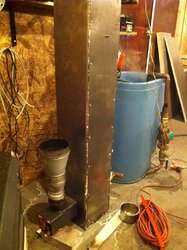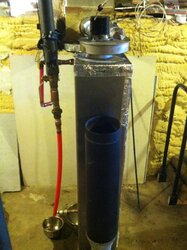I have been noodling over the concept of a batch fed pellet boiler. The idea is to use a gravity fed burner (no augers) to burn a batch of pellets at one setting and dump all the energy into storage.
It would be simple, unpressurized to keep cost down and basically function somewhat like a stickwood boiler.
Since these projects usually require time and money and I usually do not have both at the same time, it has been a little while getting it together.
What I have right now is a unit that works, without smoke, and a relatively low stack temp, 340F.
Am still testing it, but the boiler is relatively small and light and inexpensive. It has to be lit manually, but being pellets it takes about a half minute to get it going with a torch or fire starter.
Here is a brief video of the burner. Will show more as I get testing done. Right now, it delivers 50,000 btus/hr.
It does have an ID fan to keep the fire going in the right direction and not burn into the fuel tube.
It would be simple, unpressurized to keep cost down and basically function somewhat like a stickwood boiler.
Since these projects usually require time and money and I usually do not have both at the same time, it has been a little while getting it together.
What I have right now is a unit that works, without smoke, and a relatively low stack temp, 340F.
Am still testing it, but the boiler is relatively small and light and inexpensive. It has to be lit manually, but being pellets it takes about a half minute to get it going with a torch or fire starter.
Here is a brief video of the burner. Will show more as I get testing done. Right now, it delivers 50,000 btus/hr.
It does have an ID fan to keep the fire going in the right direction and not burn into the fuel tube.




 thanks for posting numbers!! 80,000 btu, half a bag in an hour and a half sounds really nice rate for most of us. I want one for my 200 gallon softtank!
thanks for posting numbers!! 80,000 btu, half a bag in an hour and a half sounds really nice rate for most of us. I want one for my 200 gallon softtank!